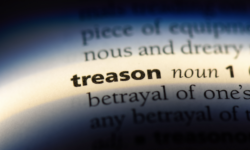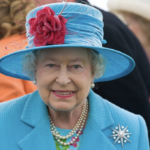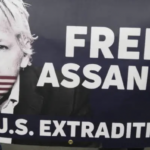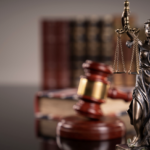The Criminal Offence of Treason: Definition, Evolution and Political Application

Treason has for hundreds of years been considered one of the most serious offences that a person can commit.
Whilst the criminal offence of treason dates at least as far back as Roman times, the vagaries and inconsistencies in what may amount to the offence are so vast and varied that, for the purposes of this article, we shall focus on when the legislation was enacted in England in 1351.
Vagueries and application
The ancient Roman words for treason, being ‘perduellio’ (generally high treason) and ‘maiestas’ (more common form of treason with several forms of spelling), varied confusingly in both definition and consequences over time.
However, this didn’t stop the English from reinstating Roman law when it suited them, as will later be explained.
This article will also take a look at some of the dynamics involved within the United Kingdom countries involving execution of royalty for treason in their individual quest for dominance from the late 1200s.
This includes one date when there was civil unrest not only in England but also the other UK countries involving King Charles 1 which is a story for another article which culminated in three civil wars.
The King was around for only two of them having been executed before the third one.
This will be followed by the outline of a number of other significant cases of treason which also ended in the execution of those who were convicted.
Within those dynamics we will draw attention to the colonisation of Canada where similar to other countries including Australia, the Indigenous peoples suffered in many ways. Particularly, the focus will be on the Metis Nation, one of three Indigenous peoples of Canada.
Origin and definition
The term treason is derived from Latin and Anglo-French language such as ‘Traditionem’ and ‘Treson’ or ‘Traison’ meaning to hand over or deliver by betrayal.
England in 1351 saw King Edward 111 give Royal Assent to the Treason Act which commenced about 14 years after the start of the 100 Year War against France.
Ireland got it in 1495 and next came Scotland much later in 1708. Wales had earlier been conquered in the late 1200s.
Treason is one of the rarest charges in legislation and still carries up to life imprisonment. In some countries ,the penalty is execution if convicted.
This crime includes significant offences against a country and/or its monarch by word or deed and includes spying, armed coups and incitement of wars.
Those who are involved in such actions are called traitors.
No death is a good death
Death by hanging within the British Empire was not a quick affair as it included torture by being dragged backwards by horses with the head on the ground to the gallows (place of execution).
The next process included hanging until close to death with the final indignation being the severing of genitals, removal of the heart and disembowelment.
Finally, what followed was decapitation with the body being quartered (cut into 4 parts) and the body parts put on public display in order to deter further treasonous acts by traitors to the Crown. Women were treated differently with being drawn and burned being the preferred method, apparently to protect their dignity.
Whilst the Treason Act 1814 (UK) changed the law in relation to the convicted male traitor to be hanged until dead, the heinous acts of dismemberment continued until 1870.
The women were no better off with the abolishment of being burned at the stake in the Treason Act 1790 apart from the fact beheading was the substitute and if one was really lucky, transportation was the punishment, particularly after the enactment of the Treason Felony Act of 1848.
Royal executions for treason
Sir William Wallace was a Scottish Knight who if alive today would have challenged Nicola Sturgeon for control of the Scottish National Party.
Sir William’s defeat of the English at the Battle of Stirling in 1297 paved the way for King Edward 1 to eventually add rebellion to the legislation of treason. Wallace was ultimately hung, drawn and quartered for High Treason in a place called Smithfield in London.
King Robert 1, otherwise known as Robert the Bruce was King of Scotland at one stage during the first war of Scottish independence.
His reign was from 1306 until his death in 1329. He was the victor of the Battle of Bannockburn in 1314 defeating King Edward 11’s English army and paving the way for Scottish independence in 1328 cemented by the Treaty of Edinburgh.
Robert the Bruce did not suffer execution for treason.
King Charles 1 ruler of England (and in essence Wales), Scotland and Ireland found himself the subject of a charge of treason against his own subjects after a decade long feud between he and his parliament from 1639 until his trial in 1649.
As legally the King could not be tried under the 1351 Treason Act as politicians have a won’t to do, they reinstated Roman Law which had a provision for a tyrant King to face a charge of treason.
The King was executed in 1649 in front of the Banqueting House in Whitehall London. One could not imagine a more squeamish setting had diners been present!
11 years later the monarchy was back in power with the son of King Charles 1 taking his father’s throne back and avenging Charles execution by gathering the regicides (those involved in the deliberate killing of a monarch in the form of a coup) and killing them all under the 1351 Treason Act.
This not only avenged his father’s death but sent a message certain to offer added protection to future monarchs. The Stuarts were back in town!
The cause of the initial feud between the king and parliament
The feud between King Charles 1 and his parliament involved money in relation to fight wars abroad and threatening his MPs that he would rule without parliament.
In addition, the King preferred the High Anglican form of worship which concerned the Puritan Protestants notwithstanding that his wife Queen Henrietta Maria of France was Catholic thus creating suspicion.
And on it went, the never-ending story of treason and executions with the 1351 Treason Act manipulated to suit those it served best. As indeed were subsequent Acts.
Most infamous acts of treasonable offences
Bonfire Night on each 5 November is celebrated by millions of people the world over and is regarded as a celebration of when the treasonable act of assassination of King James 1 was averted in 1605.
Guido (Guy) Fawkes ultimately convicted of High Treason who orchestrated the gunpowder plot to blow up the British parliament with the intention of killing the King is the reason for the celebration of Guy Fawkes night.
On this night the world skies light up in the glow of massive bonfires and a variety of colourful and sophisticated fireworks called roman candles – catherine wheels – fountains – mines – sparklers – repeaters and rockets are ignited which fly up into the sky.
The fireworks during the execution of Guy Fawkes and his co-conspirators were also enjoyed by thousands of spectators but of course not by the convicted. This was primarily because whilst alive the persons under sentence had their genitals sliced off and thrown into a fire before their very eyes, if indeed they were conscious.
Guy Fawkes though denied the King the satisfaction of this repulsive act of indignation of this part of his punishment by allegedly throwing himself from the gallows which broke his neck. It did not however stop the barbarous process from occurring.
Benedict Arnold
Despite earlier being regarded as an American hero of the American War of Independence, Benedict Arnold became a traitor who committed treason when he defected to the British Armed Forces around 1779.
Winning the war resulted in the establishment of the United States of America having achieved independence from the British Empire and forming a modern constitutional democracy.
Mr Arnold however never faced justice for his treason and indeed went on to fight against his country as a British army officer eventually retiring to England, dishonoured and disillusioned.
Canadian Indigenous peoples
The 1885 trial of a Canadian politician and leader of the Metis Nation Louis Riel who led two resistance movements against the Canadian government to preserve the Metis peoples rights – history – culture – language and lifestyle resulted in his execution for treason.
The Indigenous Metis are one of three constitutionally recognised Indigenous communities of Canada. He was hanged for High Treason but his legacy led to the Canadian government recognizing the Aboriginal peoples in the Canadian constitution where the Metis Nation was enshrined within it.
The other two Indigenous peoples are Indians and the Inuit.
In 1992, Canada passed a resolution recognizing Mr Riel as the founder of Manitoba with the Metis Nation ultimately being granted 1.25 million acres in Alberta, although they settled all over Canada and of course in many countries of the world.
Their language which is Michif and is a combination of Cree & French is currently endangered with fewer than several hundred Metis Nation citizens still fluent. However, programs are in progress to preserve their cultural language.
This is not far removed from what every colonised Indigenous First Nation Peoples could have experienced, including our own Australian Aboriginals and the potential dangers they faced with the enactment of the Treason Act, albeit several centuries later.
For history has shown that you didn’t have to lead an armed resistance movement against the government to face a charge of treason or many other criminal charges.
Lord Haw-Haw
1946 saw the prosecution of Lord Haw-Haw whose real name was William Brooke Joyce, an American born Fascist who assisted Germany during World War II by broadcasting Nazi propaganda and who was executed by hanging.
Julius and Ethel Rosenberg
American citizens and members of the Young Communists League, Julius and Ethel Rosenberg were convicted of the treasonable charge of conspiracy to commit espionage (spying for the Soviet Union).
History appears to vindicate Ethel as being a traitor and only reports Julius as being a minor participant in treason, however this is countered by other historians quoting Soviet Union documentation said to have been released after the fall of communism.
This related to passing on to the Russians, US military electronic material from a radio factory associated with Julius’ employment as an electrical engineer at the Army Signal Corp engineering laboratories.
The charge however referred to providing information to the USSR in relation to the atomic bomb which Ethel’s brother was involved in and what was known as the Manhattan Project developing nuclear weapons.
Her brother David Greenglass turned informer resulting in his sister and brother-in-law being executed by the ‘electric chair’ in the notorious Sing Sing Prison in 1953.
The most infamous traitor or the most remarkable hero of human rights
Exposing to the world from 2010 heinous abuses of human rights, war crimes and corruption versus the risk to the national security of nations and individual agents of those nations.
UK Amnesty International, Le Monde, Time Media Choice and the Sydney Peace Foundation gold medal for peace with justice, were awards presented to Julian Assange which concur with President Obama’s Department of Justice comments on Wikileaks publishing of classified information which concluded with:
“such a prosecution would pose a severe threat to press freedom because there would be no way to prosecute Assange for publishing classified documents without also prosecuting the New York Times, the Washington Post, the Guardian and others for doing exactly the same thing.
It would not and could not do so, consistent with the press freedom guarantee of the First Amendment.”
This question has been and continues to be debated in many legal jurisdictions at the highest level with no clear result appearing imminent but still Australian citizen Julian Assange languishes in a British prison.
The United States, the country where Mr Assange is the ‘Most Wanted’ wasn’t always of this opinion. The Barack Obama 44th Presidency decreed that he was not America’s most wanted however President Obama’s sentiment didn’t last long.
The Donald Trump 45th Presidency decided that he was America’s most wanted as indeed does America’s current Joe Biden’s 46thPresidency.
Australian Prime Minister Julia Gillard during her tenure stated that his actions were illegal, whilst the Australian Federal Police (AFP) commented that he had not broken any laws. Strong anecdotal evidence suggested by leaked National Security Agency (NSA) documents indicate that in 2010 Mr Assange was on what was called a US ‘manhunting timeline’ which was a reference to a clandestine national effort to capture or kill terrorists and others.
For the moment Julian Assange continues to languish in a British Prison awaiting his fate. For a detailed summary of Mr Assange’s predicament refer to recent SCL article titled ‘The Belmarsh Tribunal’.
Legal implications of being associated with treason
Australia, like that of many countries has Federal and State laws in relation to the offence of treason. The New South Wales perspective on this crime leaves nothing to the imagination about how serious this offence is regarded.
It is clear that any harm whatsoever to the King, his heir or any citizen representing the monarch in Australia (such as the Prime Minister and the Governor-General) in any overt or covert manner shall see such a person:
‘guilty of an indictable offence called treason and liable to level 1 imprisonment (life); or imprisonment for such other term as is fixed by the court as the court so determines.’
Further, any person who helps someone whom to their knowledge is guilty of treason or intends to commit treason and doesn’t inform the authorities shall be guilty of an indictable offence with the penalty being:
‘Life Imprisonment also or imprisonment for such other term as is fixed by the court as the court so determines.’
The current offence of treason in Australia
Treason is an offence under section 80.1 of the Criminal Code Act 1995 (Cth), which is an offence that applies across the nation and carries a maximum penalty of life in prison.
To establish the offence, the prosecution must prove beyond reasonable doubt that you:
- Killed the sovereign, sovereign’s heir, governor-general or prime minister, or
- Harmed the sovereign, governor-general or prime minister leading to their death, or
- Harmed, imprisoned or restrained the sovereign, governor-general or prime minister, or
- Levied war, or undertook an act preparing for war, against the Commonwealth, or
- Instigated a non-citizen to invade the Commonwealth, or one of its territories.
Self-defence is a legal defence to the charge.






